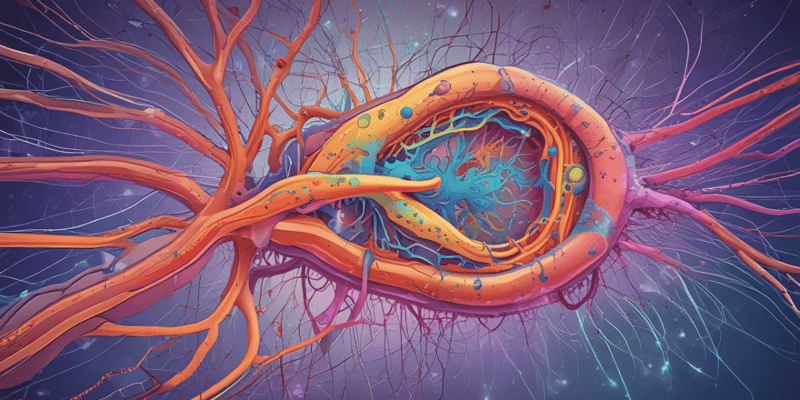Podcast
Questions and Answers
What happens when voltage-gated sodium channels open?
What happens when voltage-gated sodium channels open?
The inside of the cell is positively charged due to the presence of proteins.
The inside of the cell is positively charged due to the presence of proteins.
False
What does the Nernst equation estimate?
What does the Nernst equation estimate?
Equilibrium potential for an ion
The equation to calculate equilibrium potential for potassium (K) is given by E = _____.
The equation to calculate equilibrium potential for potassium (K) is given by E = _____.
Signup and view all the answers
Match the ion to its equilibrium potential:
Match the ion to its equilibrium potential:
Signup and view all the answers
Which two gradients direct the movement of chloride and calcium across the membrane?
Which two gradients direct the movement of chloride and calcium across the membrane?
Signup and view all the answers
The Goldman equation integrates the conductance of multiple ionic species to estimate membrane potential.
The Goldman equation integrates the conductance of multiple ionic species to estimate membrane potential.
Signup and view all the answers
Calculate the equilibrium potential for chloride if the concentrations are 110 mM inside and 10 mM outside.
Calculate the equilibrium potential for chloride if the concentrations are 110 mM inside and 10 mM outside.
Signup and view all the answers
Chloride has a concentration of _____ mM outside the cell.
Chloride has a concentration of _____ mM outside the cell.
Signup and view all the answers
When the membrane potential becomes less negative, this process is known as:
When the membrane potential becomes less negative, this process is known as:
Signup and view all the answers
Study Notes
Membrane Potential
- Refers to the separation of charges across a membrane, influenced by the relative concentrations of cations and anions in intracellular fluid (ICF) versus extracellular fluid (ECF).
- Nerves are electrically polarized, generating electrochemical impulses for signal transmission along nerve and muscle membranes.
Resting Membrane Potential (RMP)
- RMP is the potential of a neuron when inactive, measured as a voltage difference in millivolts (mV).
- Established by diffusion potentials resulting from concentration gradients of ions such as Na+, K+, and Cl-.
- The ICF contains higher levels of K+ and negatively charged proteins, leading to a more negative potential compared to the ECF, which has more Na+ and Cl-.
Nernst Equation
- A formula to determine the membrane potential for individual ions under nonstandard conditions.
- For Potassium (K+), the equation is E = 58 X log [5 / 140], resulting in E = -84 mV.
- For Chloride (Cl-), the equation is E = 58 X log [110 / 10], resulting in E = -60 mV.
- Varies with body temperature; predicts the equilibrium potential at a certain ion concentration across a membrane.
Membrane Structure
- Neuron membranes consist of a phospholipid bilayer with hydrophilic phosphate heads facing outward and hydrophobic lipid tails facing inward.
- There is a potential difference across the membrane, where the inside is negative relative to the outside.
Ion Movement and Action Potential
- The inward movement of sodium ions, due to changes in voltage-gated sodium channels, leads to rapid depolarization, making the membrane potential less negative.
- Proteins within the cell contribute to the overall negative charge of the ICF.
Ionic Ohm's Law / Chord Conductance Equation
- Estimates membrane potential using the equilibrium potentials and conductance values for each ionic species involved.
Studying That Suits You
Use AI to generate personalized quizzes and flashcards to suit your learning preferences.
Related Documents
Description
Test your understanding of membrane potential, the separation of charges across biological membranes. This quiz covers the basics of how membrane potential affects nerve polarization and the difference in ion concentrations in intracellular and extracellular fluids.



